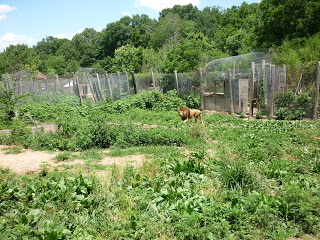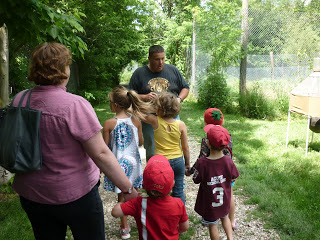Medieval History
Welcome to a new feature of the blog, named by the kids "The Indiana You Don't Know," or TIYDK for short. Even though there's no easy way to pronounce that, it's better than the title Mac and I came up with which was "kids, the new roof means no family vacation this year, so let's explore this wacky state we live in!" - much better. Our opening adventure was the Exotic Feline Rescue Center and here you see some of the kids assembled before Rodney, a leopard (look between Oliver's and Jakob's heads - there he is!), who was discovered in a home in Long Island during a police response to a domestic disturbance call. All of these cats come here through completely twisted paths, the most common being the human desire to "own" (control? possess? display? exploit? tame? what the hell are they thinking?) a wild animal. You learn crazy things while one of the many volunteers there walks you through the small path carved out for people that winds through the terrains of the 95 cats that can handle seeing humans (there are 233 cats there in all, but many of them freak at the sight of human beings): crazy things like, it's still legal to own a large wild animal in 21 states (9 don't require a license of any kind); like, tigers breed well in captivity and so are the ones most often found in the most insane situations (gang headquarters, breeding bunkers, roadside zoos). But they're safe now, they can rest - and they live alone or in groups, survivors of our wiles.
With Karl Steel's wonderful new book project in mind, I wondered about medieval exotic pets. There are leopard gifts and rhinoceros gifts (and Lawrence Norfolk's spectacular book) and Villard de Honnecourt's famous lion, "drawn from the life," and bestiaries and the leopards in the Cluny Unicorn tapestry. All gifts preoccupied with place and travel and power and presence. What must it have been like when the lion roared in his royal European park? One of the lions this afternoon (rescued from a retired Hungarian physician in Ohio), having eyed us a while, glided up to a highest point and, after a few guttural evocations, roared. I've never felt anything like it. There was steam coming from his mouth: some impossible heat from deep within his body. There was a wall of sound - not something that enveloped you, something that came at you and insisted there, pressed flat against your entire body. There was absolute stillness amongst the human beings, Oliver's heart beating fast beneath my hand as I pulled him to me. And there was nothing aggressive about the lion's stance, about his body. He wound down his sound with a series of lesser and lesser grunts, his work here done. We, completely ridiculously, so puny, but we had to give something back... clapped. The volunteer was as open-mouthed as we, saying he'd been in the visual presence of a "full roar" (wind-up to wind-down) but about ten times in his four years at the place. Wild.
And then the meat. So much meat. This tiger hunched, his lips quivering over the meat, his eyes transfixed. I wish that I could remember the numbers better, but of course it's an astounding amount of meat. Most is bought, but a good deal is given. And here, a strange symbiosis: the farmers all around, including a large number of Amish farmers, will give their carcasses to the Rescue Center, and avoid some huge processing fee as well. A kind of "everybody wins" situation, a new arrangement. Having visited a couple of Amish farms now, I can't imagine two worlds, two environments, farther apart than that of the Amish and that of these tigers - all of the Amish that we know are vegetarians whose sense of place goes deep into the roots of the soil they till. The deceased horses and milking cows they give to the Rescue Center go to tigers and lions whose feasting on raw meat was somehow frightening to see (yes yes, calling The Raw and the Cooked); animals who are now at rest after lives of upheaval and disorientation and continual uprooting. But the tigers benefit from the (many, many) Amish communities all around. They eat and eat, and so fight only briefly, over baths and playing balls and basking spots. Many shifts in morality here.
 The way this place is laid out, there are enclosures near the path in which the meat is offered and some lions and tigers who don't fear humans roam. But each encosure-near-the-path is also connected to a much wider enclosure that retreats into the forest, and even the caretakers very, very rarely if ever go in there. They have been able to observe some really fascinating behaviors, though; what I would call the big cats' manipulations of their environment. Yes, there is the marking of territory (which apparently can take up to three months and is an incredibly methodical and intentional process - much to consider here). But there are also pathways within the tall grasses that lions and especially tigers make for themselves. They tread the same ground over and over again until they have dusted out walkways within the green - and that is where they'd crouch and wait if they were hunting; it's how they claim this place as theirs now. It's their tilling. There's something here about my naïve realization that animals manipulate their environments, that they are involved in deforestation and path-making - that maybe for them nature isn't natural either.
The way this place is laid out, there are enclosures near the path in which the meat is offered and some lions and tigers who don't fear humans roam. But each encosure-near-the-path is also connected to a much wider enclosure that retreats into the forest, and even the caretakers very, very rarely if ever go in there. They have been able to observe some really fascinating behaviors, though; what I would call the big cats' manipulations of their environment. Yes, there is the marking of territory (which apparently can take up to three months and is an incredibly methodical and intentional process - much to consider here). But there are also pathways within the tall grasses that lions and especially tigers make for themselves. They tread the same ground over and over again until they have dusted out walkways within the green - and that is where they'd crouch and wait if they were hunting; it's how they claim this place as theirs now. It's their tilling. There's something here about my naïve realization that animals manipulate their environments, that they are involved in deforestation and path-making - that maybe for them nature isn't natural either.
 This place is 30 minutes from where we live and it took us ten years to get here. This is going to be a good summer. Indiana, like many Midwestern states, I think, is a strange place: flat in so many ways, and terse and plain. But beneath the lack of regulation and absence of government support, communities emerge: Amish villages, big cat rescue centers run entirely by volunteers, earth homes. And little rough touches: the poison ivy growing up the poles of the enclosures; and the decidedly down-home practice of revving Harley-Davidsons every once in a while to make the lions roar. Every body, then, making noise into the open.
This place is 30 minutes from where we live and it took us ten years to get here. This is going to be a good summer. Indiana, like many Midwestern states, I think, is a strange place: flat in so many ways, and terse and plain. But beneath the lack of regulation and absence of government support, communities emerge: Amish villages, big cat rescue centers run entirely by volunteers, earth homes. And little rough touches: the poison ivy growing up the poles of the enclosures; and the decidedly down-home practice of revving Harley-Davidsons every once in a while to make the lions roar. Every body, then, making noise into the open.
- By The River With 7th Graders, Mary Oliver, And Fafnir
There was an outing today. 150 kids, the entirety of the 7th grade, a drive out of our small town, and through Amish country to one of our glorious state parks. Warm, breezy, clear air redirected by cries of glee and teasing, kids running ahead, kids...
- Tiydk #4 & #5: Duckpin Bowling And Glacial Mud
The cats got me up early this morning, so I'm using the time to catch up on The Indiana You Don't Know (TIYDK) entries: two more in the continuing series of escapades that are substituting for a family vacation this year. Truth is, we're...
- Happy Hunting!
Gaston Phoebus - Livre de la ChasseDeer hunting season started this week-end in our fine state! And how do I know such a thing? Because the kids came home from school on Monday with reports from their buddies (in 4th and 2nd grade) of having killed...
- Children, Nature, Selves
The return from Atlanta has been a deep nesting experience (the exact opposite of Mac's days in India which have been unfurling in more and more extraordinary ways). The fifteen (!) boxes of glorious books from my beloved Donna have emerged,...
- Environments
This will be just a short pause to revel in contrasts. I don't expect to hear from Mac as his itinerary is absolutely full (art historians are utterly brutal and heartless travel companions and want to see absolutely every stash of visual culture...
Medieval History
TIYDK #1: the Exotic Feline Rescue Center
| TIYDK Kids! |
 |
| "Et sacies bien qu?il fu contrefais al vif" |
| Yikes. |
- By The River With 7th Graders, Mary Oliver, And Fafnir
There was an outing today. 150 kids, the entirety of the 7th grade, a drive out of our small town, and through Amish country to one of our glorious state parks. Warm, breezy, clear air redirected by cries of glee and teasing, kids running ahead, kids...
- Tiydk #4 & #5: Duckpin Bowling And Glacial Mud
The cats got me up early this morning, so I'm using the time to catch up on The Indiana You Don't Know (TIYDK) entries: two more in the continuing series of escapades that are substituting for a family vacation this year. Truth is, we're...
- Happy Hunting!
Gaston Phoebus - Livre de la ChasseDeer hunting season started this week-end in our fine state! And how do I know such a thing? Because the kids came home from school on Monday with reports from their buddies (in 4th and 2nd grade) of having killed...
- Children, Nature, Selves
The return from Atlanta has been a deep nesting experience (the exact opposite of Mac's days in India which have been unfurling in more and more extraordinary ways). The fifteen (!) boxes of glorious books from my beloved Donna have emerged,...
- Environments
This will be just a short pause to revel in contrasts. I don't expect to hear from Mac as his itinerary is absolutely full (art historians are utterly brutal and heartless travel companions and want to see absolutely every stash of visual culture...
